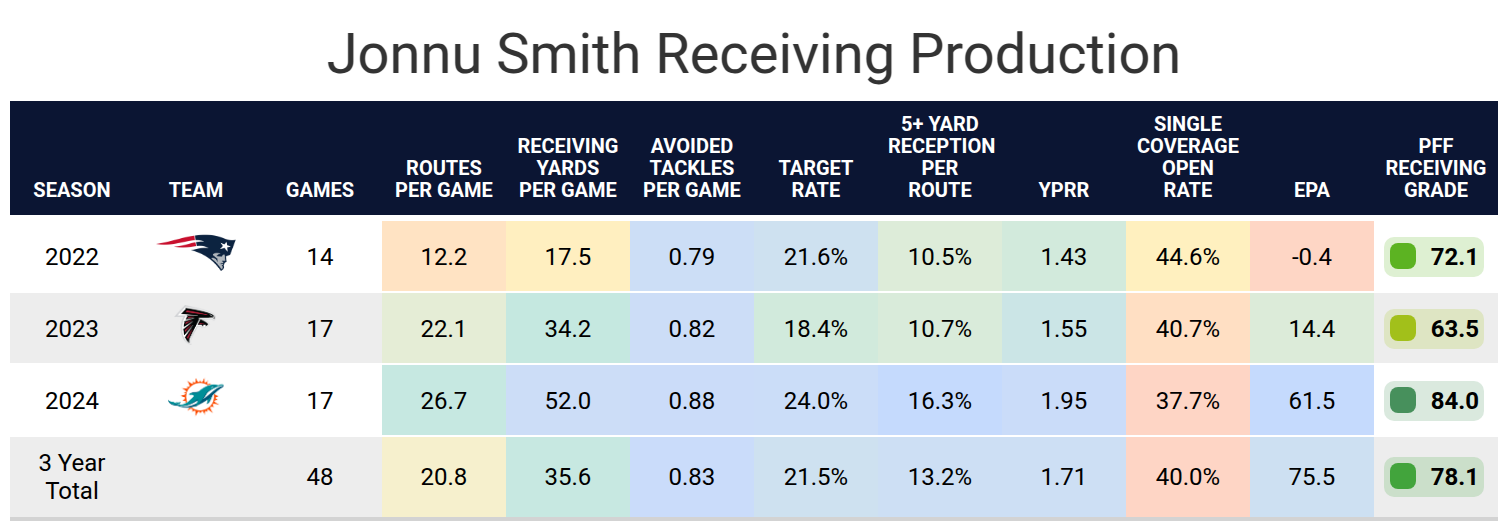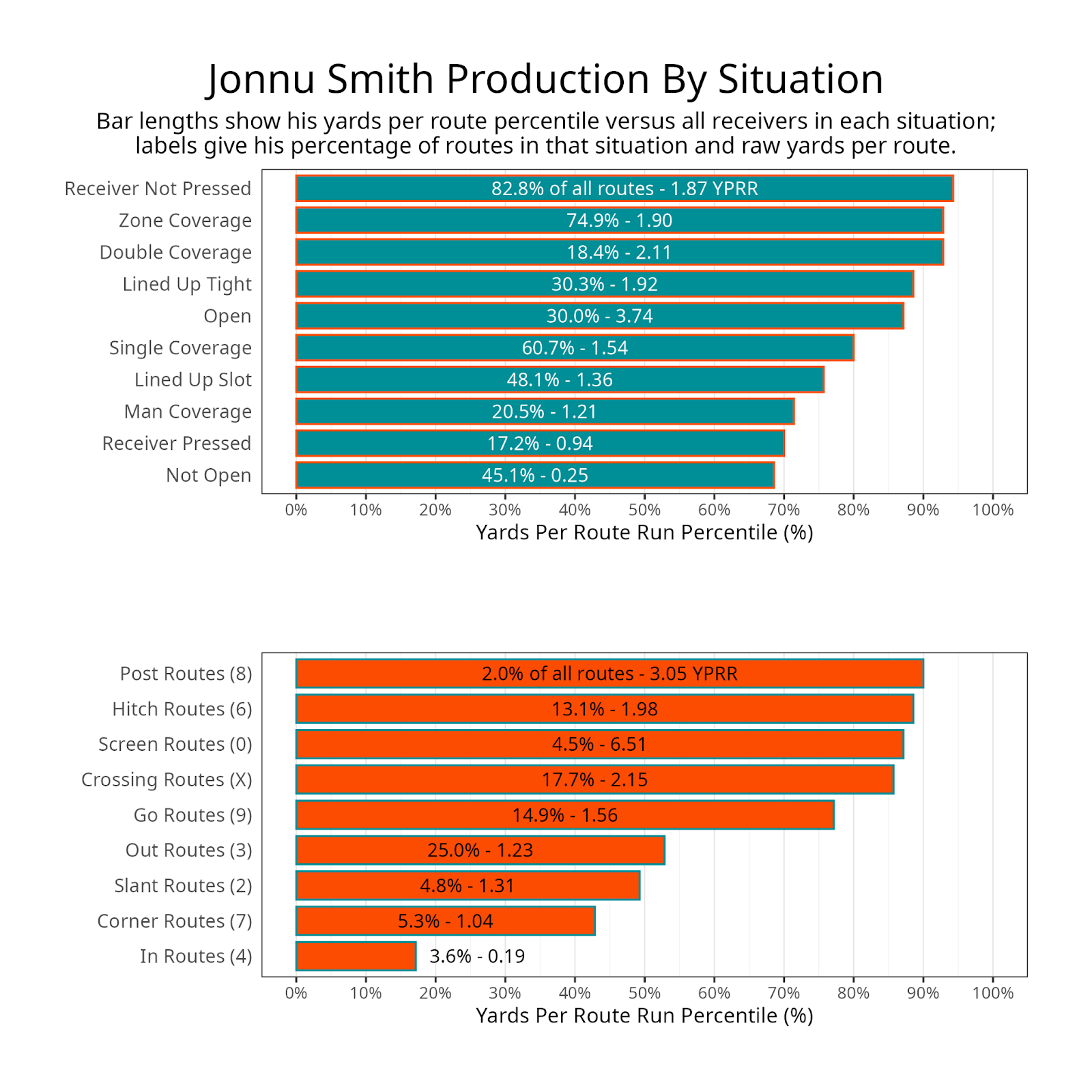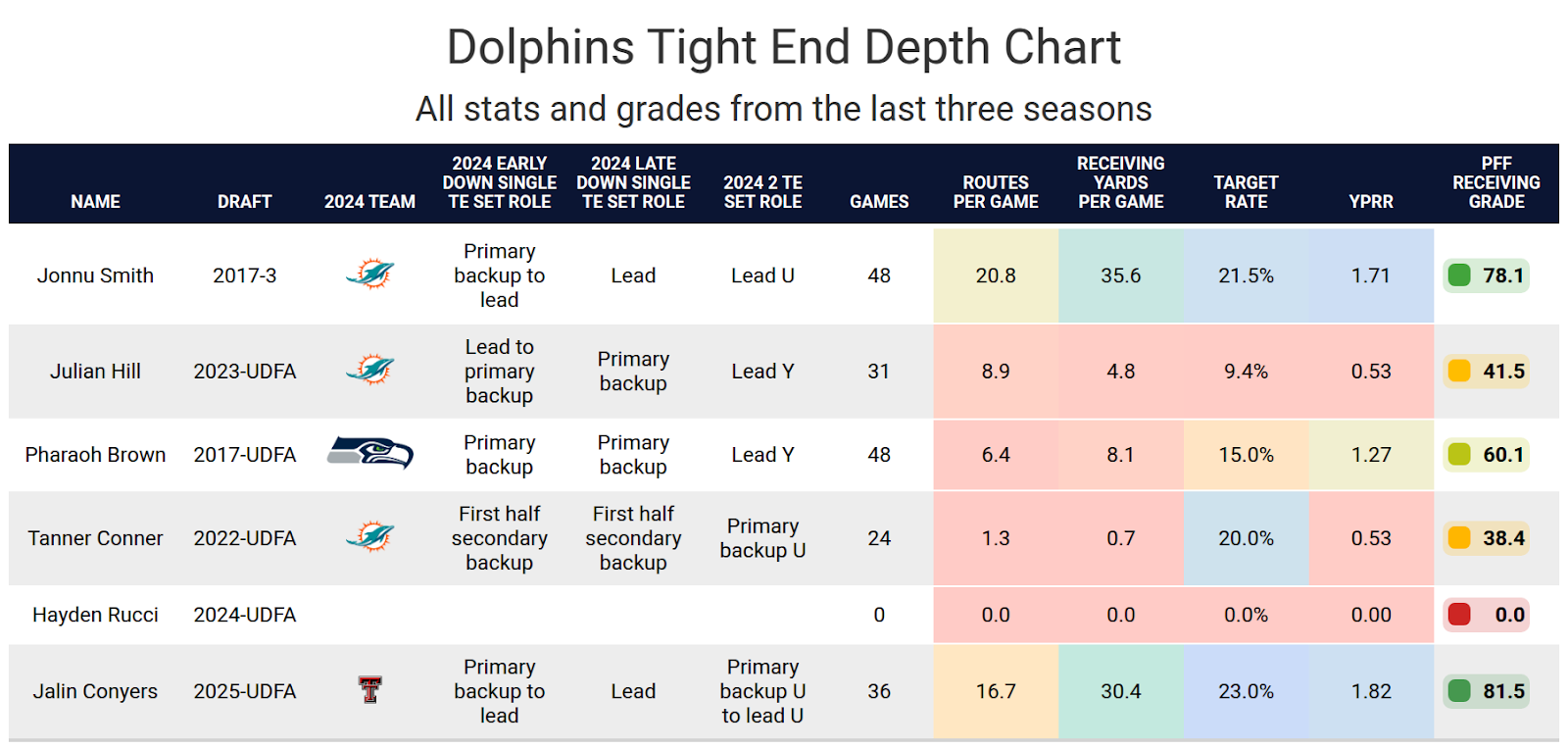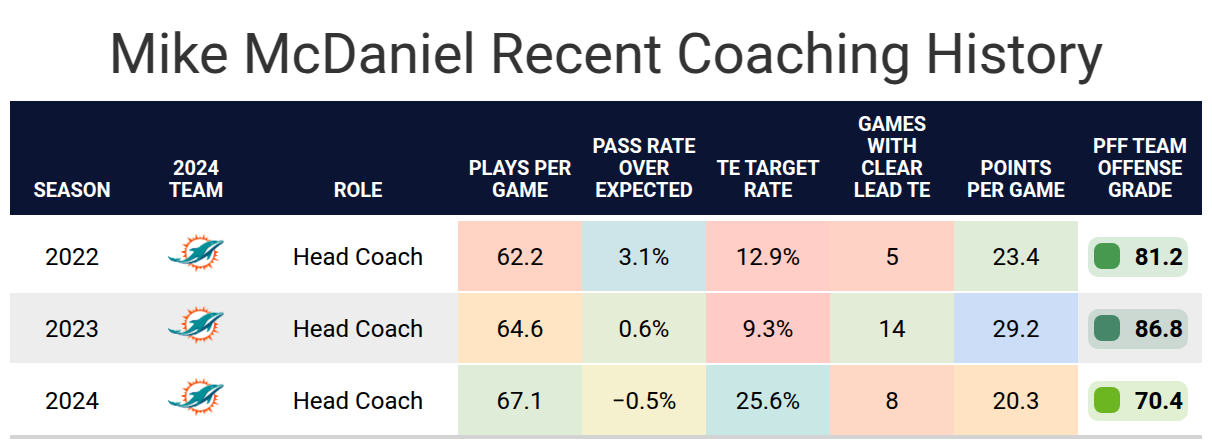
- Jonnu Smith had an eighth-year breakout: Smith played for four NFL teams, and it took the Miami Dolphins offense to unlock Smith’s fantasy potential.
- Will Tyreek Hill and Jaylen Waddle bounce back?: Both wide receiver numbers were a bit lower in 2024 compared to other seasons. If they play better this year, that could cut into Smith’s target rate.
- Subscribe to PFF+: Get access to player grades, PFF Premium Stats, fantasy football rankings, all of the PFF fantasy draft research tools and more!
Estimated Reading Time: 5 minutes

PFF’s Fantasy Football Player Profile series delivers the most in-depth fantasy football analysis available for the 2025 season.
Using PFF’s exclusive data, we evaluate player performance, competition for touches and how teammates and coaching staffs
Last updated: 7:15 a.m. Thursday, May 22
Player performance
Jonnu Smith was a third-round pick by the Tennessee Titans in 2017. He worked his way up to more playing time, and in 2019, had a 79.3 PFF receiving grade on a 35-catch, 439-receiving-yard season while playing 70% of the offensive snaps. His snap rate increased to 74.4% in 2020, and he caught eight touchdowns. However, he still received a low target volume and finished 13th in fantasy points per game despite the high touchdown total.
Smith signed a big $50.0 million contract with $31.2 million guaranteed with the New England Patriots. However, the Patriots also signed Hunter Henry. Smith ended up only playing 50.6% of the offensive snaps in his first season and 49.0% in his second, and he finished with less than two receptions per game each season. The Patriots moved on from him, so he reunited with Arthur Smith on the Atlanta Falcons. With Atlanta, he had the first two games of over 85 receiving yards in his career despite Kyle Pitts‘ presence. However, he was also under 40 receiving yards in 12 of 17 games, making it impossible to trust him for fantasy purposes.
This led to a two-year contract with the Miami Dolphins, who lacked a receiving option at tight end. Smith had a quiet start with the team, averaging 20 yards per game in September. That shot up to 60 yards per game in October and 78 yards per game in November. That dropped to 45 per game in December, but he also scored seven touchdowns in his last eight games. This was enough for a Pro Bowl birth and career-highs in basically every stat, making him a rare eighth-year breakout.
The one area in which Smith has always stood out is his ability to avoid tackles. His 0.04 avoided tackles per route is the most for tight ends since 2022. Smith will be 30 years old before the start of the season, which is typically past an age where tight ends decline. While Smith doesn’t have as many receptions as other 30-year-old tight ends, he does have over 5,000 career offensive snaps.


Projected role
Smith’s utilization changed throughout the season, which helped fuel his emergence. In the one preseason game where all the lead tight ends played, Smith played exclusively in 11 personnel, which isn’t great for a tight end’s fantasy value.
Smith averaged 65% of Miami’s offensive snaps in 11 personnel over the first six weeks, which jumped dramatically in Week 7 and held steady at 79% over the rest of the season. In 12 personnel, he only played four of a possible 24 snaps over the first two games, but that quickly changed, and he played 75% of the snaps from Weeks 3-15. However, he saw a notable decrease at the end of the season, averaging 60%. In 21 personnel, he only played 22% throughout the season. While the rate didn’t fluctuate, the Dolphins stopped using as much 21 personnel in the second half of the season compared to the first half, giving Smith more opportunities to play in the other personnel groupings.
The Dolphins moved on from long-time tight end Durham Smythe and added Pharaoh Brown, who happened to be the player who replaced Smith in New England. He’s primarily a blocking tight end. While Brown won’t be a threat to Smith in 11 personnel, the Dolphins could use the duo of Julian Hill and Brown a lot in two tight end sets.
His competition for targets will come from Tyreek Hill, Jaylen Waddle and De’Von Achane. Both wide receivers had notably down seasons last year. If they can rebound this season, that could impact Smith’s target rate. If one of the wide receivers rebounds, he can still be a top-eight fantasy tight end. If both rebound, he might only be a borderline fantasy starter. If neither do, he should be a top-five fantasy tight end again.


Impact of teammates
Smith will have Mike McDaniel as his head coach and Tua Tagovailoa as his quarterback for a second-straight season. McDaniel had no problem changing his philosophy around tight ends with Smith on the roster. McDaniel spent one year as the San Francisco 49ers‘ offensive coordinator and multiple years as their run game coordinator, all with George Kittle on the roster. While Smith isn’t as good as Kittle, it’s understandable that McDaniel knew how to use a tight end but just didn’t have one to utilize in Miami previously.
While other players in the Dolphins had strong splits with and without Tua Tagovailoa last season, Smith found success in both situations. His seven-catch, 96-yard and one-touchdown performance came the week before Tagovailoa returned from injury. However, Smith had two 100-yard games that occurred with Tagovailoa at quarterback. Tagovailoa is a good quarterback, and importantly, doesn’t scramble or get sacked as often as other quarterbacks, which is good for the fantasy value of all Dolphins receivers.


Bottom line
Smith’s 2024 season was very promising, but a lot depends on how well the other players in the offense are playing. Smith played well in a down year from both Tyreek Hill and Jaylen Waddle, but at least one of the wide receivers should rebound.

Footnotes
- Statistics in tables and charts were chosen based on their ability to predict future fantasy performance on a per-game or per-opportunity basis or to describe the player relative to others at the same position.
- “Opportunities” are defined as passing dropbacks, rushing attempts and routes run as a receiver.
- Numbers are provided either by season or based on the past three years. For rookies, only college statistics are included. For non-rookies, only NFL statistics are considered, regardless of whether they played in college within the previous three years.
- As college competition is easier than NFL competition, most rookies are likely to see a decline from their historical numbers.
- Only FBS data is considered for college players and comparisons.
- Kneel-downs are removed from rushing data to provide cleaner quarterback rushing rate statistics.
- The table colors in this article range from blue (indicating good/high) to red (indicating bad/low).
- All percentiles and color codings compare the given player to others with a high sample of opportunities. Generally, the cutoff is one-third of the possible opportunities in the sample. If a player does not meet the threshold, they are still included in the comparison, though their results may appear better or worse than expected due to the smaller, less predictive sample size.
- Information on utilization classifications and their importance can be found here for running backs, wide receivers and tight ends.
This news was originally published on this post .






Be the first to leave a comment